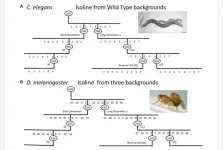(Press-News.org) Contact: Morgan Sherburne, morganls@umich.edu
Images
ANN ARBOR—If you look at massive galaxies teeming with stars, you might be forgiven in thinking they are star factories, churning out brilliant balls of gas. But actually, less evolved dwarf galaxies have bigger regions of star factories, with higher rates of star formation.
Now, University of Michigan researchers have discovered the reason underlying this: These galaxies enjoy a 10-million-year delay in blowing out the gas cluttering up their environments. Star-forming regions are able to hang on to their gas and dust, allowing more stars to coalesce and evolve.
In these relatively pristine dwarf galaxies, massive stars—stars about 20 to 200 times the mass of our sun—collapse into black holes instead of exploding as supernovae. But in more evolved, polluted galaxies, like our Milky Way, they are more likely to explode, thereby generating a collective superwind. Gas and dust get blasted out of the galaxy, and star formation quickly stops.
Their findings are published in the Astrophysical Journal.
"As stars go supernova, they pollute their environment by producing and releasing metals," said Michelle Jecmen, study first author and an undergraduate researcher. "We argue that at low metallicity—galaxy environments that are relatively unpolluted—there is a 10-million-year delay in the start of strong superwinds, which, in turn, results in higher star formation.”
The U-M researchers point to what's called the Hubble tuning fork, a diagram that depicts the way astronomer Edwin Hubble classified galaxies. In the handle of the tuning fork are the largest galaxies. Huge, round and brimming with stars, these galaxies have already turned all of their gas into stars. Along the tines of the tuning fork are spiral galaxies that do have gas and star-forming regions along their compact arms. At the end of the tuning fork's tines are the least evolved, smallest galaxies.
"But these dwarf galaxies have just these really mondo star-forming regions," said U-M astronomer Sally Oey, senior author of the study. "There have been some ideas around why that is, but Michelle's finding offers a very nice explanation: These galaxies have trouble stopping their star formation because they don't blow away their gas."
Additionally, this 10-million-year period of quiet offers astronomers the opportunity to peer at scenarios similar to the cosmic dawn, a period of time just after the Big Bang, Jecmen said. In pristine dwarf galaxies, gas clumps together and forms gaps through which radiation can escape. This previously known phenomenon is called the "picket fence" model, with UV radiation escaping between slats in the fence. The delay explains why gas would have had time to clump together.
Ultraviolet radiation is important because it ionizes hydrogen—a process that also occurred right after the Big Bang, causing the universe to go from opaque to transparent.
"And so looking at low-metallicity dwarf galaxies with lots of UV radiation is somewhat similar to looking all the way back to the cosmic dawn," Jecmen said. "Understanding the time near the Big Bang is so interesting. It's foundational to our knowledge. It's something that happened so long ago—it's so fascinating that we can see sort of similar situations in galaxies that exist today."
A second study, published in the Astrophysical Journal Letters and led by Oey, used the Hubble Space Telescope to look at Mrk 71, a region in a nearby dwarf galaxy about 10 million light years away. In Mrk 71, the team found observational evidence of Jecmen's scenario. Using a new technique with the Hubble Space Telescope, the team employed a filter set that looks at the light of triply ionized carbon.
In more evolved galaxies with lots of supernova explosions, those explosions heat gas in a star cluster to very high temperatures—to millions of degrees Kelvin, Oey said. As this hot superwind expands, it blasts the rest of the gas out of the star clusters. But in low metallicity environments such as Mrk 71, where stars aren't blowing up, energy within the region is radiated away. It doesn't have the chance to form a superwind.
The team's filters picked up a diffuse glow of the ionized carbon throughout Mrk 71, demonstrating that the energy is radiating away. Therefore, there is no hot superwind, instead allowing dense gas to remain throughout the environment.
Oey and Jecmen say there are many implications for their work.
"Our findings may also be important in explaining the properties of galaxies that are being seen at cosmic dawn by the James Webb Space Telescope right now," Oey said. "I think we're still in the process of understanding the consequences."
Studies:
Delayed massive-star mechanical feedback at low metallicity
Nebular C IV 1550 imaging of the metal-poor starburst Mrk 71: Direct evidence of catastrophic cooling
END
Dwarf galaxies use 10-million-year quiet period to churn out stars
2023-11-21
ELSE PRESS RELEASES FROM THIS DATE:
New report highlights vital contribution of ‘virtual schools’ for children in care
2023-11-21
A new study highlights the vital contribution of ‘virtual schools’ for children in care and recommends ten ways to improve their educational outcomes.
The research, by the University of Exeter and the National Association of Virtual School Heads (NAVSH), shows strong disparities in progress and attainment for children in care depending on where they live. They found these differences are not driven by neighbourhood deprivation but by patchy distribution of school places, confused funding policies and variable regulation.
As a result, some virtual schools have difficulty ...
Parental age effect on the longevity and healthspan of flies and worms
2023-11-21
“[...] little work [has been] published on the effect of parental age in the nematode Caenorhabditis elegans, a common model organism for aging studies.”
BUFFALO, NY- November 16, 2023 – A new research paper was published in Aging (listed by MEDLINE/PubMed as "Aging (Albany NY)" and "Aging-US" by Web of Science) Volume 15, Issue 21, entitled, “Parental age effect on the longevity and healthspan in Drosophila melanogaster and Caenorhabditis elegans.”
Several studies have investigated the effect of parental age on biological ...
Two new UW–Madison-led studies inform outlook on scaling of carbon removal technologies
2023-11-21
MADISON, Wis., - Carbon dioxide removal (CDR) technologies that could be critical tools to combat climate change have developed in line with other technologies from the last century. However, according to new studies led by Gregory Nemet, a professor at the University of Wisconsin–Madison, these technologies need to develop faster to meet policy targets aimed at limiting global warming.
As policymakers, researchers and climate activists from around the world prepare to meet for the UN Climate Change Conference beginning on ...
Nuclear physics traineeship program offers launchpad for research careers
2023-11-21
Associate Professor of physics Benjamin Jones has received a $341,571 grant from the U.S. Department of Energy to continue his successful traineeship program at The University of Texas at Arlington.
The program exposes undergraduate students to opportunities in particle and nuclear physics, which offer key components in many diverse careers, such as nuclear medicine, radiation therapy, archaeology, precision management and astrophysics.
UTA’s Nuclear Research Experiences for Minority Students (NREMST) started in 2021 with the goal of immersing students from historically underrepresented populations in nuclear physics.
“We know that many students ...
Experts from the UK and South America join forces for major new study of mental health reform
2023-11-21
A major new research project will explore the impact of transformational changes to mental health treatment in South America.
Community-based care for people with psychosocial disabilities began in the region in the 1960s and 1970s, when a minority of people were moved from large and isolated psychiatric hospitals to residential alternatives in the community.
This policy was promoted by the World Health Organization and the Pan America Health Organization and is considered a defining element of the modernisation of mental health systems. But in current analysis of this process the ethical, social and political tensions associated ...
Bacteria store memories and pass them on for generations
2023-11-21
Scientists have discovered that bacteria can create something like memories about when to form strategies that can cause dangerous infections in people, such as resistance to antibiotics and bacterial swarms when millions of bacteria come together on a single surface. The discovery — which has potential applications for preventing and combatting bacterial infections and addressing antibiotic-resistant bacteria — relates to a common chemical element bacterial cells can use to form and pass along these memories to their progeny over later generations.
Researchers ...
Forest modeling shows which harvest rotations lead to maximum carbon sequestration
2023-11-21
CORVALLIS, Ore. – Forest modeling by Oregon State University scientists shows that a site’s productivity – an indicator of how fast trees grow and how much biomass they accumulate – is the main factor that determines which time period between timber harvests allows for maximum above-ground carbon sequestration.
The findings, published in the journal Forests, are important for Pacific Northwest forest managers seeking to strike an optimal balance between harvesting and carbon sequestration, an important tool in the fight against climate change.
The study by Catherine Carlisle, Temesgen Hailemariam ...
The bilingual brain may be better at ignoring irrelevant information
2023-11-21
People who speak two languages may be better at shifting their attention from one thing to another compared to those who speak one, according to a study published this month in the journal Bilingualism: Language and Cognition.
The study examined differences between bilingual and monolingual individuals when it comes to attentional control and ignoring information that isn’t important at the time, said its authors Grace deMeurisse, a University of Florida Ph.D. candidate studying linguistics, and Edith Kaan, ...
Promising target for CAR T cells helps cancer trick the immune system
2023-11-21
(MEMPHIS, Tenn. – November 21, 2023) Findings from St. Jude Children’s Research Hospital are moving the field of cancer immunotherapy one step closer to treating brain and solid tumors. Scientists at St. Jude validated a cellular immunotherapy target called 78-kDa glucose-regulated protein (GRP78) in proof-of-principle experiments. The group also discovered a resistance mechanism whereby some tumors trick the cancer-killing immune cells into expressing GRP78, thereby turning off the immune cells or causing them to be killed, too. The research, which has implications for developing immunotherapy for the broad range of difficult-to-treat ...
Researchers help unravel brain processes involved in vision
2023-11-21
TORONTO, Nov. 21, 2023 – Faced with images that break the expected pattern, like a do not enter sign where a stop sign is expected, how does the brain react and learn compared to being shown images which match what was predicted?
That was the question a team, including York University, set out to answer. A long-standing theory suggests the brain learns a predictive model of the world and its internal predictions are updated when incoming sensory data proves them wrong. However, what the researchers found surprised them, says York Faculty of Science Associate Professor Joel Zylberberg, co-corresponding author of the newly published paper.
“Testing ...





